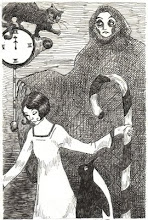 I think I have a shiny new obsession which is really the very last thing in this world that I need right now. A friend's remarkable facebook photo led me to this post on Coilhouse.
I think I have a shiny new obsession which is really the very last thing in this world that I need right now. A friend's remarkable facebook photo led me to this post on Coilhouse.Sigh. I am completely, gobsmackingly in love. The photo at left, and the others posted are actors in costume from the original 1908 Moscow Art Theatre production of Maeterlinck's The Blue Bird.
I've been staring at these pictures for a day now, and all I can think is that we live in aesthetically barren times. Or maybe I'm just out of step with the prevailing aesthetic of my own time, which is far more likely. I wrote about this a little earlier and I am more obsessed than ever with the art (both commercial and fine) in the late 19th and early 20th centuries. Mind you, I have no desire to live in those times as I like voting and birth control and computers and antibiotics, but the art was really, really lovely.
I went to acting school in a long ago other lifetime, and this is where I first realized that I find a lot of theater to be really, really boring. I blame a lot of this on American theater artists in the 20th century foisting their very male oriented emotional melodramas upon all of us, worshiping at the shrine of Stanislavsky - but, wait. An interesting little fact: the director of this remarkable looking production of Maeterlinck's very interesting fairy tale was none other than Constantin Stanislavsky.
Although lots of people have conflated that goddamn Method with the teachings of Stanislavsky, they are really entirely different. I'll take the Russians any day, clearly. I realize I'm on shaky ground here, as my most loyal commenter Fuzzy Bastard knows infinitely more about these things than I do (two of my most constant readers have studied theater in Moscow, actually) so I'll return to what I can talk about with some kind of authority.

By which, I suppose I mean the realms of the visual and of fairy tales. I don't think many people could put together a convincing argument against the statement that the commercial and book illustration of the turn of the last century was unmatched by anything either before or since. The combined elements of new, modern printing techniques, a strong pre-Raphaelite influence, art nouveau, a fashion in elaborately illustrated gift books, and the resurgence of the literary fairy tale formed a perfect eco-system for the best illustration ever seen.
The super high end work like Arthur Rackham, Edmund Dulac and Kay Nielsen (who lived long enough to do a lot of the artwork for the Night on Bald Mountain sequence of Fantasia) is so good I can't even get my head around how it was done on an even basic technique level. But I think the ones who influenced me most deeply when I was a child reading fairy tales and learning how to draw were the lesser lights like H.J. Ford and John R. Neill. Probably because I could figure out how it was done. One of the things I've always found particularly delightful about Neill is that his work is so obviously a part of the mechanical, steam age. The artistic pairing with L. Frank Baum was perfection.
The photos of the actors dressed for Stanislavsky's production of The Blue Bird have a bit of that same machine-age feel. I've been fascinated with Maeterlinck's play since I was a child and read Noel Streatfeild's wonderful book Ballet Shoes in which Pauline and Petrova played Mytyl and Tytyl in a West End production of the play. There was a silent film version directed by Maurice Tourneur (which looks lovely) and a later sound version with Shirley Temple (which looks dreadful). It has been pretty solidly out of fashion since then.
What worries me is that looking at all this makes me want to do nothing else besides directing an elaborately staged and designed revival.

















3 comments:
the (comic book) artists who most closely work in this kind of style today are Charles Vess and Michael W. Kaluta. MWK and Elaine Lee's Starstruck is being reprinted in an expanded form right now (if you're into comic feminist sci-fi).
I like Charles Vess, but I've never seen anything of his that even comes within the ballpark of Dulac or Nielsen. No one can match their watercolor technique IMO. He's an artist I always feel I should like more than I actually do. Michael Kaluta does remind me of some of the fin de siecle illustrators very much, particularly in terms of his compositions. He draws so beautifully, and I have no doubt he spent a lot of time staring at Rackham and (especially) Windsor McCay
It's too often forgotten that Stanislavsky developed The Method specifically as part of a long search for how to stage Maeterlinck's super-abstract plays. Previous productions had been characterized by, as Stanislavsky put it, "hollow-voiced speechifying", and the whole point of emotional memory and the like was to invest the actor's work with some feeling to back up all the visual spectacle. Applying it to Chekhov came more than a decade later.
On the other hand, the Maeterlinck performances were flops, and the Chekhov performances were hits, so then there's that.
Post a Comment